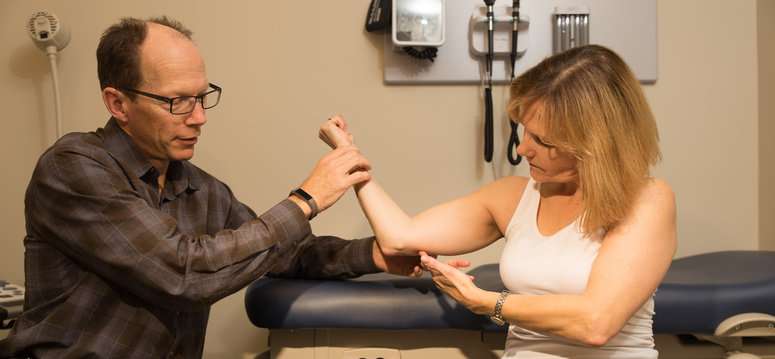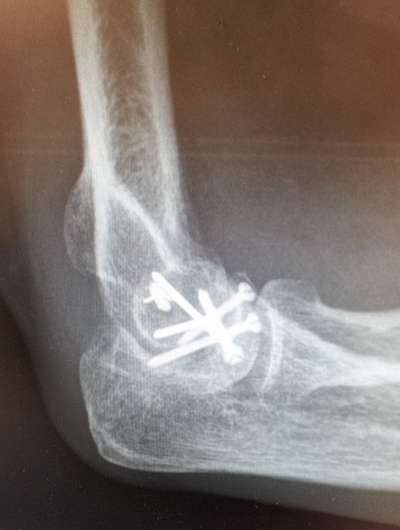Asthma medication may prevent loss of joint motion following injury

One cold morning in January 2015, Jacqueline Burrus ran to catch a bus and slipped on the ice. She put her right arm out to break her fall, and in that instant her life was changed forever.
"I hit the ground, got up right away, brushed the snow off my coat and walked on the bus. It wasn't until I sat down that I realized my elbow was killing me." An X-ray and CT scan confirmed she had multiple fractures in the bones that make up the elbow—the radius, humerus and ulna—and she was immediately scheduled for surgery.
The road to recovery has been long for Burrus. "After the surgery my elbow was locked in a 90 degree angle," she says. "I had severe pain and after seven months I still couldn't move my elbow." She was referred to Dr. Kevin Hildebrand for a second surgery to help regain her range of motion, but even after months of physiotherapy her elbow mobility is still severely restricted.
Stiff elbows often occur post-surgery
Loss of joint motion following an injury, otherwise known as a post-traumatic contracture, is a common complication following fractures. "Many people with elbow fractures or dislocations lose elbow motion and 10 to 15 per cent require surgery," says Hildebrand, an orthopedic surgeon and University of Calgary researcher in the Cumming School of Medicine's McCaig Institute for Bone and Joint Health. "People with a joint contracture can have trouble dressing, eating, grooming and reaching. They're simple little things we take for granted but make a huge difference in daily life."
For Burrus, the impact of her injury is significant. "It's been a big challenge to learn how to live like this," she says. "I've had to learn to do everything, including write, with my left hand. All the sports I used to enjoy—swimming, yoga, skiing, volleyball—I can't do anymore. I often have horrendous pain in my shoulder and neck because those muscles do a lot of compensating for my elbow."

Research suggests new purpose for asthma drug
Hildebrand's research focuses on the joint capsule, the critical structure that limits motion after an injury. The joint capsule connects the ends of the bones that form a joint and is made of ligaments and tendons. In an injured joint capsule there is an increased number of mast cells, a cell type associated with inflammation, asthma and excessive scarring.
Hildebrand's research has shown that ketotifen, a medication used to treat asthma for over 40 years, shows promise in preventing post-traumatic contractions. Ketotifen works by inhibiting the activity of mast cells. "The prospects of using this drug to treat contractures is exciting. We know it is safe, it's readily available in pill form and it's inexpensive," says Hildebrand. But before ketotifen can be prescribed for joint injuries, its effectiveness needs to be proven.
With funding from the U.S. Department of Defense, Hildebrand has launched a multi-centre clinical trial in 16 centres across North America. The four-year study, which begins in April 2018, will recruit 702 people who have sustained an elbow injury that requires surgery. Participants will randomly receive either ketotifen or a placebo for six weeks after surgery, and then elbow range of motion will be measured for up to one year after the injury.
Ketotifen offers hope for the future
At this point, Burrus doesn't qualify for the ketotifen study because the drug needs to be given right after surgery, but she sees hope in the new study. "I wouldn't want anyone else to go through what I have, because this has been an interesting adventure," says Burrus. "I do have faith that there is way to resolve this issue somehow."















